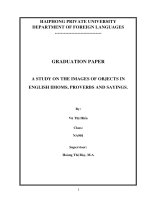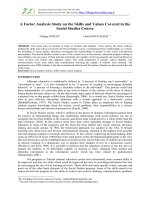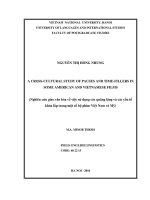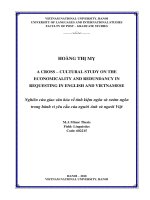a cross - cultural study on the economicality and redundancy in requesting in english and vietnamese = nghiên cứu giao văn hóa về tính kiệm ngôn và rườm ngôn trong hành vi yêu cầu của người anh và người việt tt
Bạn đang xem bản rút gọn của tài liệu. Xem và tải ngay bản đầy đủ của tài liệu tại đây (234.31 KB, 4 trang )
VIETNAM NATIONAL UNIVERSITY, HANOI
UNIVERSITY OF LANGUAGES AND INTERNATIONAL STUDIES
FACULTY OF POST – GRADUATE STUDIES
HOÀNG THỊ MỴ
A CROSS – CULTURAL STUDY ON THE
ECONOMICALITY AND REDUNDANCY IN
REQUESTING IN ENGLISH AND VIETNAMESE
Nghiên cứu giao văn hóa về tính kiệm ngôn và rườm ngôn
trong hành vi yêu cầu của người Anh và người Việt
M.A Minor Thesis
Field: Linguistics
Code: 602215
HANOI – 2010
VIETNAM NATIONAL UNIVERSITY, HANOI
UNIVERSITY OF LANGUAGES AND INTERNATIONAL STUDIES
FACULTY OF POST – GRADUATE STUDIES
HOÀNG THỊ MỴ
ON THE ECONOMICALITY AND REDUNDANCY IN
REQUESTING IN ENGLISH A
A CROSS – CULTURAL STUDY ND VIETNAMESE
Nghiên cứu giao văn hóa về tính kiệm ngôn và rườm ngôn
trong hành vi yêu cầu của người Anh và người Việt
M.A Minor Thesis
Field: Linguistics
Code: 602215
By: Hoang Thi My – K16C
Supervisor: Do Thi Mai Thanh, M.A
HANOI - 2010
6
TABLE OF CONTENTS
Declaration i
Acknowledgements ii
Abstract iii
List of abbreviations iv
List of tables v
PART A: INTRODUCTION 1
1. Rationale and the statement of the problem 1
2. Aims of the study 3
3. Significance of the study 3
4. Scope of the study 4
5. Method of the study 4
PART B: DEVELOPMENT 5
CHAPTER 1: LITERATURE REVIEW 5
1.1. Speech acts and classification of speech acts 5
1.2. Requesting as a speech act 7
1.3. Redundancy and classification of redundancy 9
1.3.1. Redundancy 9
1.3.2. Classification of redundancy 10
1.3.2.1. Modality redundancy 10
1.3.2.2. Habitual redundancy 11
1.3.2.3. Insufficient redundancy 11
1.4. Economicality and classification of economicality 11
1.4.1. Economicality 11
1.4.2. Classification of economicality 11
1.4.2.1. Modality economicality 11
1.4.2.2. Habitual economicaltiy 12
1.4.2.3. Insufficient economicality 12
1.5. Lexico modal markers 12
7
1.6. Previous studies on lexico modal markers, addresser’s/addressee’s gender and relative
age when making requests. 15
CHAPTER 2: METHODOLOGY 18
2.1. Research design 18
2.2. Participants 18
2.3. Data collection instrument 19
2.4. Data collection procedures. 20
2.5. Data analysis methods and procedures 20
CHAPTER 3: FINDINGS AND DISCUSSION 22
3.1. The popularity of economicality and redundancy in requesting 22
3.2. The link between the addresser’s/ addressee’s gender and relative age and the use of
lexico modal makers seen as redundancy – creating factors 24
3.2.1. The use of lexico modal markers for communicative partner of same sex and
younger 25
3.2.2. The use of lexico modal markers for communicative partner of same sex and older. 29
3.2.3. The use of lexico modal markers for communicative partner of opposite sex and
younger. 33
3.2.4. The use of lexico modal markers for communicative partner of opposite sex and
older .36
PART C: CONCLUSION 40
1. Conclusions 40
2. Pedagogical implications 41
3. Suggestions for further study 42
REFERENCES 43
APPENDIX I









